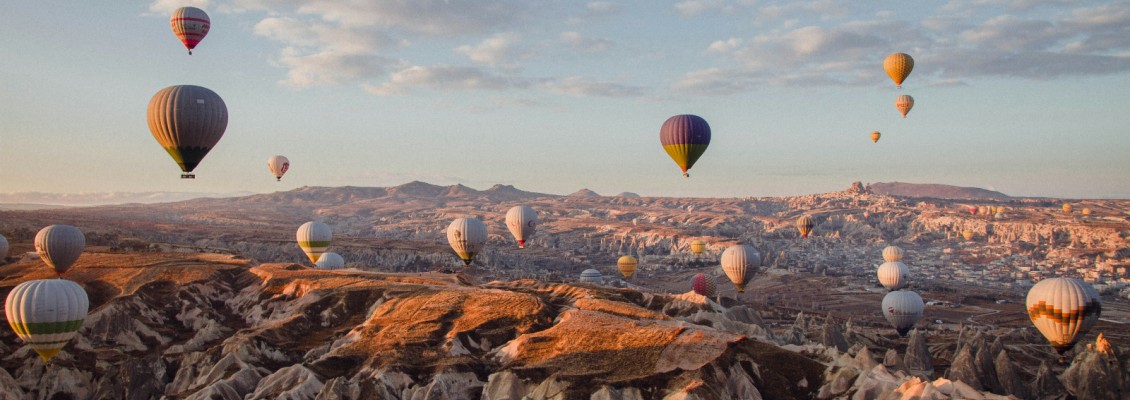
WONDERS OF TURKEY: CAPPADOCIA
Cappadocia, one of Türkiye’s most historical and mesmerising regions, draws tourists from around the world with its unique landscapes, rich history, and a wide range of activities. The region called Cappadocia consists of five cities: Nevsehir, Aksaray, Nigde, Kayseri and Kırsehir. However, its core attractions are often associated with the towns of Uchisar, Göreme, Avanos, Ürgüp, Derinkuyu, Soganlı, and Ihlara. From ancient cave dwellings to surreal volcanic formations, Cappadocia offers a blend of natural wonder and cultural heritage that is truly fascinating.
The region has been home to a variety of civilizations, including the Hittites, Phrygians, Persians, Romans, and Byzantines. Due to its strategic location, Cappadocia was a crossroads for trade routes, including the famed Silk Road. The Silk Road has been the path not only of merchants, but also of sages, armies, ideas, religions and cultures from east to west and from west to east. For this reason, it is possible to see various structures and cultural richness from different periods and nations.
When people think of Cappadocia, one of the first images that come to mind is the region’s iconic hoodoos, also known as "fairy chimneys." These unique rock formations are a defining feature of Cappadocia’s landscape, and they play a significant role in the region’s identity and appeal. These geological wonders are not just a natural curiosity; they have also played a crucial role in the cultural history of Cappadocia. Early inhabitants of the region recognized the practicality of the soft tuff rock and began carving out homes, churches, and entire underground cities within these formations. The fairy chimneys provided shelter, protection, and a sense of community, particularly during times of conflict when people needed to hide from invaders. The best places to view these remarkable formations include: Göreme National Park, Pasabag (Monks Valley) and Love Valley.
Where to visit?
Göreme National Park and Open-Air Museum: National Park is a vast area that encompasses some of Cappadocia’s most remarkable landscapes, including valleys, rock formations, and ancient cave dwellings. The park is particularly popular with hikers and nature lovers who come to experience its beauty and panoramic views. Hot air balloon rides over Göreme National Park are also a popular way to take in the breathtaking scenery from above. Located within the national park, the Göreme Open-Air Museum is a remarkable complex of rock-cut churches, chapels, and monasteries, many of which date back to the 10th to 12th centuries. This site is often considered the heart of early Christian monastic life in Cappadocia and serves as an important example of Byzantine art and architecture.The Dark Church, The Apple Church, The Buckle Church and The Snake Church are some churches where you can enjoy Byzantine and religious art and architecture.
Uçhisar Castle: Uçhisar Castle is
not a traditional castle built from stone blocks but rather a massive natural
rock formation that has been hollowed out over centuries to create a
fortress-like complex. The castle's strategic location at the top of a hill
made it an ideal lookout point and defensive stronghold throughout history.
Visitors can explore the labyrinth of tunnels, rooms, and stairs that weave
through the castle. Though many of the interior spaces are now inaccessible due
to erosion and safety concerns, the accessible areas provide a fascinating
glimpse into how people lived within this natural fortress. The real highlight
of a visit to Uçhisar Castle, however, is the climb to the top. The ascent
involves navigating narrow steps and passages, but the effort is rewarded with
extraordinary views over Cappadocia’s surreal landscape.
Hot Air Balloon Rides: Perhaps the most iconic activity in Cappadocia,
hot air ballooning offers a bird’s-eye view of the region’s surreal landscapes.
Floating above the fairy chimneys, valleys, and vineyards at sunrise is an
experience that is both peaceful and exhilarating.
Derinkuyu Underground City: As the largest of the many underground cities in the region, Derinkuyu offers a fascinating glimpse into the lives of its ancient inhabitants who created an elaborate subterranean network to escape threats from invaders. Visitors can explore its eight accessible levels, although it’s believed that the city may extend even deeper, with more levels yet to be uncovered. Those who have difficulty bending and do not like closed spaces should be careful as it can be claustrophobic in the tunnels.
Ihlara Valley: Ihlara Valley has been inhabited since ancient
times, with its earliest settlements dating back to the 4th century. Early
Christian communities found refuge in the valley, carving out homes, churches,
and monasteries in the soft volcanic rock. Tourits can embark on a scenic hike
along the river, exploring the natural beauty and historical sites that line
the path. The hike through the valley can be as short or as long as you like,
with several entry and exit points along the way.

Leave a Comment